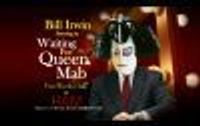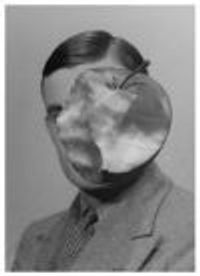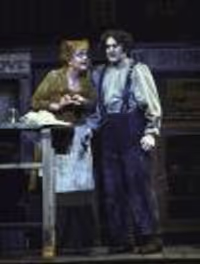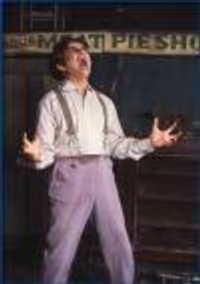Into the Woods representing AIDS
#1Into the Woods representing AIDS
Posted: 1/16/09 at 11:21pmI read somewhere recently (though can't recall where!) that some view Into the Woods as an allegory for AIDS... , that the giant represents AIDS. And another point being that many of the characters who have sex end up suffering.... Does anyone know if this is a valid interpretation? and if so, what are some other points to back it up?
#2re: Into the Woods representing AIDS
Posted: 1/16/09 at 11:24pmSondheim himself said it wasn't the case.
#2re: Into the Woods representing AIDS
Posted: 1/16/09 at 11:36pm
The thought that INTO THE WOODS is about AIDS never crossed my mind.
And appearently it never crossed Sondheim's either.
#3re: Into the Woods representing AIDS
Posted: 1/16/09 at 11:43pmI can't tell you how many times in college I would have some professor talk about the hidden meanings and metaphors represented in various films or plays, only to find out from the authors (or filmmakers through DVD commentary) that many of those "hidden meanings" were just accidents or flat out unintentional. Which once again proves Woody Allen's take on the old saying, "Those who can't do, teach. And those who can't teach, teach gym."
#4re: Into the Woods representing AIDS
Posted: 1/16/09 at 11:54pm
I don't think it's directly about AIDS, but it definitely ties in, in that it explores how people respond to tragedies and larger than life conflicts, which the AIDS crisis certainly falls under. As for the sex thing, the only major sexual act depicted is the Baker's Wife and Cinderella's Prince, and she dies, but he really doesn't feel any consequences. I guess you could infer that Cinderella and her Prince have slept together, and she's kind of unhappy in the middle of Act 2, but again, the Prince doesn't really suffer. And the Baker and his wife have to have done it, but nothing really horrible happens as a direct consequence.
Wow, I'm overanalyzing this. I'll stop now.
#5re: Into the Woods representing AIDS
Posted: 1/17/09 at 12:13am
Sondheim has said NO, NO, NO,
and I believe that.
But any great work of Art resonates for the audience who sees it as something related to your Life at the time.
#6re: Into the Woods representing AIDS
Posted: 1/17/09 at 12:20amSondheim said no, but it makes sense. Didn't he play "No One is Alone" at Michael Bennett's funeral or was that "Childre and Art"? Some song from 80s Lapine shows.
FindingNamo
Broadway Legend Joined: 7/22/03
#7re: Into the Woods representing AIDS
Posted: 1/17/09 at 12:53amIn 1987 it was not unreasonable to sit in the audience at the Martin Beck as the epicenter of the raging AIDS epidemic was right outside the walls of that theater and think that the show was a metaphorical representation of it. The creators said no, but it sure felt otherwise.
#8re: Into the Woods representing AIDS
Posted: 1/17/09 at 12:57amI don't believe that was Sondheim's intention with the show...but there is something to be said about how the only survivors are the innocent...
#9re: Into the Woods representing AIDS
Posted: 1/17/09 at 1:17am
The whole world was about AIDS in 1987. At least, the world people like Namo and I lived in.
"No One Is Alone" was sung at many AIDS memorials. Mandy Patinkin sang it at the memorial at the Winter Garden for my friend Reed Jones, who played Skimbleshanks in the original Broadway cast of Cats.
But innocence was not the sole territory of the survivors.
FindingNamo
Broadway Legend Joined: 7/22/03
#10re: Into the Woods representing AIDS
Posted: 1/17/09 at 1:20amYou can say that again.
#11re: Into the Woods representing AIDS
Posted: 1/17/09 at 2:21am
God. Some of you people seem to forget that Sondheim didn't even write the story! So either way it certainly would have not been his intention.
Sondheim gets too much credit for his shows IMO.
#12re: Into the Woods representing AIDS
Posted: 1/17/09 at 2:29amSondheim also agrees that he gets too much credit for his shows. He's always saying that the book writers of his musicals deserve more credit.
Phyllis Rogers Stone
Broadway Legend Joined: 9/16/07
#13re: Into the Woods representing AIDS
Posted: 1/17/09 at 4:36amDo not put your faith in a cape and hood; they will not protect you the way that they should.
#14re: Into the Woods representing AIDS
Posted: 1/17/09 at 4:47am
"Sondheim also agrees that he gets too much credit for his shows. He's always saying that the book writers of his musicals deserve more credit."
True.
There was a three-day Sondheim conference at Goldsmiths College in London back in 2005, at which one of the major themes explored was why the Sondheim contribution to his shows seems to overshadow the book-writers'.
As for the AIDS metaphor, just because it wasn't a conscious metaphor, doesn't mean to say it wasn't an unconscious one. But personally I don't go with it.
#15re: Into the Woods representing AIDS
Posted: 1/17/09 at 7:10am
FindingNamo and PalJoey are right. I'm sure Sondheim and Lapine didn't consciously intend it as a metaphor for AIDS, but when you sat in the Martin Beck in 1987 and the Witch said, "Wake up! People are dying all around you," it was impossible not to think of it.
Is the Giant a metaphor for AIDS? No. But did the AIDS epidemic resonate with (I'm sure) many people at certain points while watching the original production? I'm sure it did. And it's hard to imagine that Sondheim and Lapine weren't on some level aware of it.
#16re: Into the Woods representing AIDS
Posted: 1/17/09 at 11:33am
I remember reading (probably from an uncredible source) that not only did the original serve as a metaphor for the aftershocks of AIDS, but the revival in 2002 was metaphorical for the fight against terrorism/twin towers falling, etc.
Isn't that the fundamental nature of art? Onlookers find things the artist never intended, yet the piece still spoke to them.
NobodyHome & PhyllisR - very powerful lines to bring up.
#17re: Into the Woods representing AIDS
Posted: 1/17/09 at 11:34am
"Do not put your faith in a cape and hood; they will not protect you the way that they should."
Wow, that really does sound like it would relate... but I guess not consciously.
I was thinking after posting this... Does Sondheim have any allegorical shows?
Jon
Broadway Legend Joined: 2/20/04
#18re: Into the Woods representing AIDS
Posted: 1/17/09 at 11:52amAt the time, there were also those who thought the Giant represented nuclear holocaust.
#19re: Into the Woods representing AIDS
Posted: 1/17/09 at 12:49pmTo me, "Last Midnight" represented mercury poisoning.
#20re: Into the Woods representing AIDS
Posted: 1/17/09 at 1:19pm
Into the Woods is a broader allegory than just AIDS, I believe it's about life and every/any aspect of it.
The Giant, to me, represents death and consequences.
"If artists were machines, then I'm just a different kind of machine...I'd probably be a toaster. Actually, I'd be a toaster oven because they're more versatile. And I like making grilled cheese" -Regina Spektor
"That's, like, twelve shows! ...Or seven." -Crazy SA Fangirl
"They say that just being relaxed is the most important thing [in acting]. I take that to another level, I think kinda like yawning and...like being partially asleep onstage is also good, but whatever." - Sherie Rene Scott
#21re: Into the Woods representing AIDS
Posted: 1/17/09 at 1:26pm
I think people should stop trying to find the underlying metaphors and such within plays and just friggin' DO them. This is especially the case with Shakespeare. He was a great playwright, but people overanalyze his work so much it drives me CRAZY! It's like, "I don't know why he wrote the line that way. Maybe he just thought it sounded pretty. Whatever the case, I'm just going to do my job as an actor and try to connect with the text and tell the friggin' story!"
FindingNamo
Broadway Legend Joined: 7/22/03
#22re: Into the Woods representing AIDS
Posted: 1/17/09 at 1:30pm
Odd argument, Distinctive, since nobody has once said in this thread that it's the job of the actor to represent specific metaphors not explicitly defined in the text. Since the dawn of speech, story telling and myth making have served the explicit purpose of reflecting back the lives of their audiences, for themselves to see themselves in it or not.
If people in 1987 saw a reflection of the AIDS epidemic during Into the Woods, the art of theatre was doing its job for them. If people saw a terrorism metaphor during the revival production, they were dumb but not "wrong".
#23re: Into the Woods representing AIDS
Posted: 1/17/09 at 1:54pmYou misunderstand me. I am happy to have audiences interpret plays any way they want. If someone saw a production of "Into the Woods" I was in and came away thinking about AIDS, and it was a valuable theatre experience for them, great. Really, I was just taking a moment to b*tch about the self-congratulatory interpretation of plays I heard for four years as a double major in Theatre and English in college and for the continued B.S. I hear from directors who are working way too hard.
gypsy4
Broadway Legend Joined: 8/14/07
#24re: Into the Woods representing AIDS
Posted: 1/17/09 at 7:53pmwhat has Lapine say about the whole thing he is the one who wrote the shows book.
Videos














